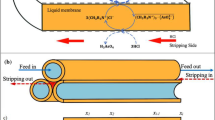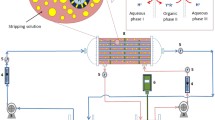Abstract
The present paper focuses on the working and application of hollow fiber strip dispersion system for the removal of metal ions from aqueous streams. Conventional separation methods like chemical precipitation, adsorption, ion exchange and solvent extraction are in use to eliminate and recover heavy metals from aqueous solutions, but suffer from their inherent limitations like less efficiency, high operating costs, secondary sludge production and disposal. Liquid membrane in comparison with these methods offers little investment, high flux, less solvent and energy consumption. Supported liquid membrane is preferred for the removal and reclamation of metal ions as this technique offers simultaneous extraction and stripping. Hollow fiber supported liquid membrane is being used successfully for the separation of various metal ions, but instability and extended functioning are the concerned issues for industrial usage. Pseudo-emulsion hollow fiber strip dispersion system solves the instability issue by maintaining uninterrupted supply of organic membrane phase in pores and successfully removes the metal ions. This paper mainly focuses on the effect of various parameters like concentration of metal, carrier and type of diluent on the removal of metal ions from aqueous streams. Permeation model development and evaluation of mass transfer coefficients are also discussed here.


Similar content being viewed by others
References
V.S. Kislik, in Liquid Membranes: Principles and Applications in Chemical Separations and Wastewater Treatment, ed. by V.S. Kislik (Elsevier, Great Britain, 2010), p. 5
V.S. Kislik, Solvent Extraction: Classical and Novel Approaches, 1st edn. (Elsevier, Great Britain, 2012), pp. 501–502
P. Dżygiel, P.P. Wieczorek, in Liquid Membranes: Principles and Applications in Chemical Separations and Wastewater Treatment, ed. by V.S. Kislik (Elsevier, Great Britain, 2010), p. 76
P.K. Parhi, J. Chem. (2013). https://doi.org/10.1155/2013/618236
K. Nath, Membrane Separation Processes, 1st edn. (Prentice-Hall of India Private Limited, New Delhi, 2008), p. 244
A. Gabelman, S.T. Hwang, J. Membr. Sci. (1999). https://doi.org/10.1016/S0376-7388(99)00040-X
Z. Ren, W. Zhang, Y. Liu, Y. Dai, C. Cui, Chem. Eng. Sci. (2007). https://doi.org/10.1016/j.ces.2007.06.005
T. Pirom, A. Arponwichanop, U. Pancharoen, T. Yonezawa, S. Kheawhom, Sci. Rep. (2018). https://doi.org/10.1038/s41598-018-25771-4
H.P. Kohli, S. Gupta, M. Chakraborty, Colloids Surf. A (2020). https://doi.org/10.1016/j.colsurfa.2019.124308
S.C. Roy, J.V. Sonawane, N.S. Rathore, A.K. Pabby, P. Janardan, R.D. Changrani, P.K. Dey, S.R. Bharadwaj, Sep. Sci. Technol. (2008). https://doi.org/10.1080/01496390802064141
H.P. Kohli, S. Gupta, M. Chakraborty, J. Wat. Process Eng. (2019). https://doi.org/10.1016/j.jwpe.2019.100880
J.V. Sonawane, A.K. Pabby, A.M. Sastre, AIChE J. (2008). https://doi.org/10.1002/aic.11371
K. Wieszczycka, M. Regel-Rosocka, K. Staszak, A. Wojciechowska, M.T.A. Reis, M.R.C. Ismael, M.L.F. Gameiro, J.M.R. Carvalho, Sep. Purf. Technol. (2015). https://doi.org/10.1016/j.seppur.2015.09.017
J.V. Sonawane, A.K. Pabby, A.M. Sastre, J. Membr. Sci. (2007). https://doi.org/10.1016/j.memsci.2007.05.016
J.V. Sonawane, A.K. Pabby, A.M. Sastre, J. Hazard. Mater. (2010). https://doi.org/10.1016/j.jhazmat.2009.09.085
S. Gupta, M. Chakraborty, Z.V.P. Murthy, Sep. Purf. Technol. (2013). https://doi.org/10.1016/j.seppur.2013.04.020
S. Agarwal, M.T.A. Reis, M.R.C. Ismael, J.M.R. Carvalho, Sep. Purif. Technol. (2014). https://doi.org/10.1016/j.seppur.2014.02.039
S. Agarwal, M.T.A. Reis, M.R.C. Ismael, J.M.R. Carvalho, Sep. Purif. Technol. (2016). https://doi.org/10.1016/j.seppur.2016.03.031
M.T.A. Reis, M.R.C. Ismael, A. Wojciechowska, I. Wojciechowska, P. Aksamitowski, K. Wieszczycka, J.M.R. Carvalho, Sep. Purf. Technol. (2019). https://doi.org/10.1016/j.seppur.2019.04.076
F.J. Alguacil, M. Alonso, F.A. Lopez, A. Lopez-Delgado, I. Padilla, H. Tayibi, Chem. Eng. J. (2010). https://doi.org/10.1016/j.cej.2009.11.016
N.S. Rathore, A. Leopold, A.K. Pabby, A. Fortuny, M.T. Coll, A.M. Sastre, Hydrometallurgy (2009). https://doi.org/10.1016/j.hydromet.2008.08.009
P. Ramakul, T. Supajaroon, T. Prapasawat, U. Pancharoen, A.W. Lothongkum, J. Ind. Eng. Chem. (2009). https://doi.org/10.1016/j.jiec.2008.09.011
F.J. Alguacil, I. Garcia-Diaz, F. Lopez, A.M. Sastre, Sep. Purif. Technol. (2011). https://doi.org/10.1016/j.seppur.2011.05.029
L. Pei, L. Wang, W. Guo, N. Zhao, J. Membr. Sci. (2011). https://doi.org/10.1016/j.memsci.2011.05.037
S. Agarwal, M.T.A. Reis, M.R.C. Ismael, M.J.N. Correia, J.M.R. Carvalho, Sep. Purif. Technol. (2013). https://doi.org/10.1016/j.seppur.2012.09.026
F.J. Alguacil, I. Garcia-Diaz, F.A. Lopez, J. Ind. Eng. Chem. (2013). https://doi.org/10.1016/j.jiec.2012.12.003
A. Mondal, S. Ghosh, A. Bhowal, S. Datta, Sep. Sci. Technol. (2013). https://doi.org/10.1080/01496395.2012.723103
S. Chaturabul, W. Srirachat, T. Wannachod, P. Ramakul, U. Pancharoen, S. Kheawhom, Chem. Eng. J. (2015). https://doi.org/10.1016/j.cej.2014.12.034
R. Vijayalakshmi, S. Chaudhury, M. Anitha, D.K. Singh, S.K. Aggarwal, H. Singh, Int. J. Miner. Process. (2015). https://doi.org/10.1016/j.minpro.2015.02.003
S.A. Allahyari, S.J. Ahmadi, A. Minuchehr, A. Charkhi, RSC Adv. (2017). https://doi.org/10.1039/c6ra26463h
F.J. Alguacil, M. Alonso, F.A. Lopez, A. Lopez-Delgado, Sep. Purif. Technol. (2009). https://doi.org/10.1016/j.seppur.2009.01.012
Author information
Authors and Affiliations
Corresponding authors
Additional information
Publisher's Note
Springer Nature remains neutral with regard to jurisdictional claims in published maps and institutional affiliations.
Rights and permissions
About this article
Cite this article
Kohli, H.P., Gupta, S. & Chakraborty, M. Applicability of Hollow Fiber Strip Dispersion for the Removal of Metal Ions from Aqueous Streams. J. Inst. Eng. India Ser. E 101, 91–97 (2020). https://doi.org/10.1007/s40034-020-00163-4
Received:
Accepted:
Published:
Issue Date:
DOI: https://doi.org/10.1007/s40034-020-00163-4




